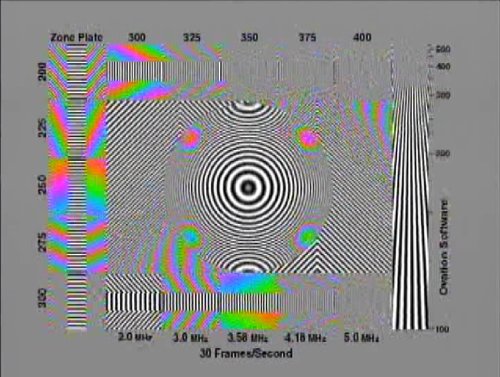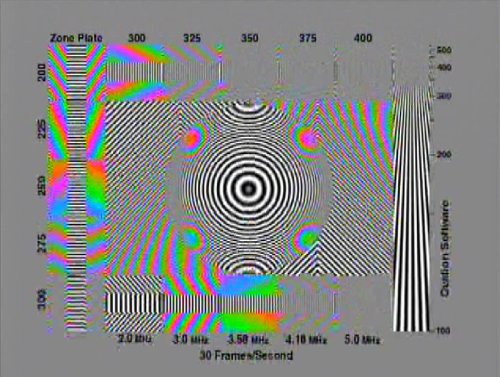The New Theater 650 TV Tuner Solution from ATI
by Josh Venning on June 14, 2006 4:00 AM EST- Posted in
- Smartphones
- Mobile
Image and Video Quality
Probably the most subjective yet important element of a TV tuner card is its ability to play and record high quality video. There are many factors involved in determining how good the video quality is and certain things like sharpness can be good or bad depending on user preference. That's why it's nice that ATI has added more user control over this and other aspects of image quality through the new software with the Theater 650.
ATI provided us with a DVD that contains some test videos to compare image quality between these three cards. To allay any suspicions of foul play, these test videos were created by SMPTE (the Society of Motion Picture and Television Engineers) for the express purpose of testing analog television quality. These videos include still and moving images to test how well a tuner applies things like sharpness and noise reduction. We recorded all of the tests with each of the tuners to provide a consistent test video for comparison between cards, and you can download the complete videos using your favorite BitTorrent client. (Total size of the three videos is 345 MB.) Note that we used ATI's AVIVO utility to convert all of the files to MPEG-4 format from the default MCE .ms MPEG-2 format. This was done to reduce file size, and we did verify that there was no discernible change in image quality (the original files totaled over 1 GB in size). In order to avoid any errors in our own analysis, we used the original files while drawing our conclusions.
It is also important to point out that we didn't just run a DVD player straight into a composite video input. We ran our DVD player through a modulator set up to output on channel 3. This way were were able to provide each card with a source data in the same format as if the images were broadcast and recieved over a cable connection. Feeding in analog video directly would bypass the tuner and demodulator on the card and wouldn't present a full test of the hardware, but our solution gives us the ability to repeat tests easily using a reliable source. The images below are taken from the original video files.
As we mentioned in the introduction, ATI has improved their 3D comb filter with the Theater 650 over the 550 by making it motion adaptive. This means that moving objects will be much cleaner and sharper compared to those without this feature. As you can see in the above images, the fruit in the Theater 650 capture looks similar to the 550, but the color is cleaner, especially near the edges of the tomato. You can also see that the DualTV has some problems with displaying the edges of the tomato and stand properly while in motion. This is one case where we see a clear improvement by ATI over NVIDIA in image quality.
In the above images, we can also see how there is slightly more detail in certain areas of the test pattern with the Theater 650 compared to the 550, and both are ahead of the DualTV. The loss of detail is noticeable near the upper and lower right hand corners of the image where some of the fine lines tend to blur together. There are also fewer color artifacts with the Theater 650 due to its higher quality 3D comb filter.
As a final example, we can see the difference in the color between the Theater 650 and 550 in these images, and the 650 gives the woman's skin tones a better treatment. There isn't a very big difference here between the Theater 650 and DualTV but you can see how the colors are generally brighter on the Theater 650 due to the new automatic color control.
These are only some of the tests on the DVD (there are eight tests in all) which demonstrate the Theater 650's better overall image quality than the 550. From these results we can definitely see how ATI has improved over the 550 as well the DualTV with their new Theater card.
Probably the most subjective yet important element of a TV tuner card is its ability to play and record high quality video. There are many factors involved in determining how good the video quality is and certain things like sharpness can be good or bad depending on user preference. That's why it's nice that ATI has added more user control over this and other aspects of image quality through the new software with the Theater 650.
ATI provided us with a DVD that contains some test videos to compare image quality between these three cards. To allay any suspicions of foul play, these test videos were created by SMPTE (the Society of Motion Picture and Television Engineers) for the express purpose of testing analog television quality. These videos include still and moving images to test how well a tuner applies things like sharpness and noise reduction. We recorded all of the tests with each of the tuners to provide a consistent test video for comparison between cards, and you can download the complete videos using your favorite BitTorrent client. (Total size of the three videos is 345 MB.) Note that we used ATI's AVIVO utility to convert all of the files to MPEG-4 format from the default MCE .ms MPEG-2 format. This was done to reduce file size, and we did verify that there was no discernible change in image quality (the original files totaled over 1 GB in size). In order to avoid any errors in our own analysis, we used the original files while drawing our conclusions.
It is also important to point out that we didn't just run a DVD player straight into a composite video input. We ran our DVD player through a modulator set up to output on channel 3. This way were were able to provide each card with a source data in the same format as if the images were broadcast and recieved over a cable connection. Feeding in analog video directly would bypass the tuner and demodulator on the card and wouldn't present a full test of the hardware, but our solution gives us the ability to repeat tests easily using a reliable source. The images below are taken from the original video files.
As we mentioned in the introduction, ATI has improved their 3D comb filter with the Theater 650 over the 550 by making it motion adaptive. This means that moving objects will be much cleaner and sharper compared to those without this feature. As you can see in the above images, the fruit in the Theater 650 capture looks similar to the 550, but the color is cleaner, especially near the edges of the tomato. You can also see that the DualTV has some problems with displaying the edges of the tomato and stand properly while in motion. This is one case where we see a clear improvement by ATI over NVIDIA in image quality.
In the above images, we can also see how there is slightly more detail in certain areas of the test pattern with the Theater 650 compared to the 550, and both are ahead of the DualTV. The loss of detail is noticeable near the upper and lower right hand corners of the image where some of the fine lines tend to blur together. There are also fewer color artifacts with the Theater 650 due to its higher quality 3D comb filter.
As a final example, we can see the difference in the color between the Theater 650 and 550 in these images, and the 650 gives the woman's skin tones a better treatment. There isn't a very big difference here between the Theater 650 and DualTV but you can see how the colors are generally brighter on the Theater 650 due to the new automatic color control.
These are only some of the tests on the DVD (there are eight tests in all) which demonstrate the Theater 650's better overall image quality than the 550. From these results we can definitely see how ATI has improved over the 550 as well the DualTV with their new Theater card.



















78 Comments
View All Comments
rqle - Wednesday, June 14, 2006 - link
Currently own a Theater 550 chipset and i like it much better then my roommate nvidia dualTV one. My question is, can i buy another Theater550 so i can dualTV, would the system go crazy on me? Would like to have dual screen running different sport program at once and would be cheaper for me as well.DerekWilson - Wednesday, June 14, 2006 - link
that would work fineWoodchuck2000 - Wednesday, June 14, 2006 - link
When is Anandtech going to publish a decent article on TV tuners? In no particular order:Why use ATI promotional material that is designed to prove that the 650 is better than the 550? Use your own material if you want a fair test. More to the point, why transcode it? Im sorry, but file size considerations are not a good justification for degrading the image quality <IN AN IMAGE QUALITY TEST>.
How do you justify adding throwaway comments about equivalence with Hauppage products in the conclusions if you havn't addressed the cards at any point in the review?
Why have you taken the instantaneous CPU utilisation from task manager and tabulated it? You need to take an average over a reasonable period of time if it is to have any relevance.
Seriously, there's not enough depth in any area to make the review really worthwhile - you may as well post a single page saying "Look everyone, ATI have sent us this nice new card they want us to plug!" and it would have the same amount of relevance to 99% of your audience.
Cardio - Wednesday, June 14, 2006 - link
Why is there no mention of how this card preforms on DTV, that is its major difference and only really new feature? Am I missing something here? You didn't test the Hauppauge because you have looked at it before. You've looked at the ATI 550 before also. In the earlier test you campare a dual tuner card to a single tuner card rather to the other available dual tuner card. Will ATI only give you stuff to test if you don't compare it to the competition? As you said, Nvidia's card is only available directly from them and at twice the price. The Hauppauge MCE 500 is available anywhere and is cheap. Oh, you have looked at those cards before.I can tell you for sure that I am a lot more interested in Picture Quality and functionality than in power consumption or cpu usage.
Not worthy of AT and its getting to be a habit.
DerekWilson - Wednesday, June 14, 2006 - link
We transcoded it for your benefit (smaller file to download) -- in our image quality analysis, we used the unmodified output of the cards. Sorry if this was unclear.As for using ATI's material, you can't argue with a zone plate. Better is better and worse is worse. Same for the other tests we ran which were designed by SMPTE (http://www.smpte.org/)">http://www.smpte.org/) ... ATI was gracious enough to provide us with these tests we would have otherwise had to purchase ourselves.
testing the Hauppage card is a reasonable request, but it doesn't change the fact that it was similar in quality and performance to the Theater 550 in previous evaluations. That is perfectly reasonable information to use in drawing conclusions.
SHSPVR - Wednesday, June 14, 2006 - link
One thing I really hate more then anything is the fact that min reviewer are so lazy in the cheating game by using the PrtScn Button and do not do ture original video RAW decode MPEG screenshot in the rigth application software like Womble MPEG-VCR and always seem to be using MCE DVR-MS proprietary video and audio format carp what matter are they just to lazy in using other PVR software or GraphEdit to get real MPEG files but as we all know that the NVIDIA DualTV is not option with GraphEdit which has no exposes advanced features properties.2nd problem as today no body turely using low bitrate under 4MBit/sec which is more reasonable testing to see how well it really dose encoding without artifacts.
So you wondering why I said cheating well each encoder dose there video difference from each other and there for the decoder filter display difference in case depend on the clean up filter like Deinterlace, difference Enhanced Video Processing Technologies which get apply on top the MPEG Video.
Now as for comparison.
Hauppauge, ATI and NVIDIA
Hands down Hauppauge PVR cards wins becuase of some major reason it has support for more OS then any one eles Windows, Linux, Mac (Apple) and yes even OS/2 Warp or eComStation and has more 3rdparty application support.
As for a real encoding comparison all test they should done with the fellowing device
VCR, Stardard Antenna TV, CableTV Analogue/Digital and Satellite with fellowing output source S-Video/Composite and Tuner
CPU Utilization is really useless becuase all of today Video card are still mostly base on 3rdparty SW-Decoder which mean you still need fast CPU unlike a ture HW-Decoder which provides a real decoding performance unlike today video card which only do part HW-accelerated decoding not full HW-decoding.
Let say for Example you have Intel P3 800MHz runing 2000Pro or XP with 512MB and you can chosse from GeForce"4" MX4000 or GeForce"7" 7800 becuase you want upgarde your old doggie ATI 3D RAGE PRO 4MB what do you think you see in CPU Utilization from the two card newer card.
andrep74 - Tuesday, June 20, 2006 - link
One thing I really hate more [than] anything is the fact that I have to try to read cr*p like your comments, which try to pass off the sh*t in your head for English.SHSPVR - Wednesday, June 14, 2006 - link
Oh I also for add You need do Cartoon as well as reg video show